七年级英语重点句型总结
- 格式:doc
- 大小:26.50 KB
- 文档页数:2
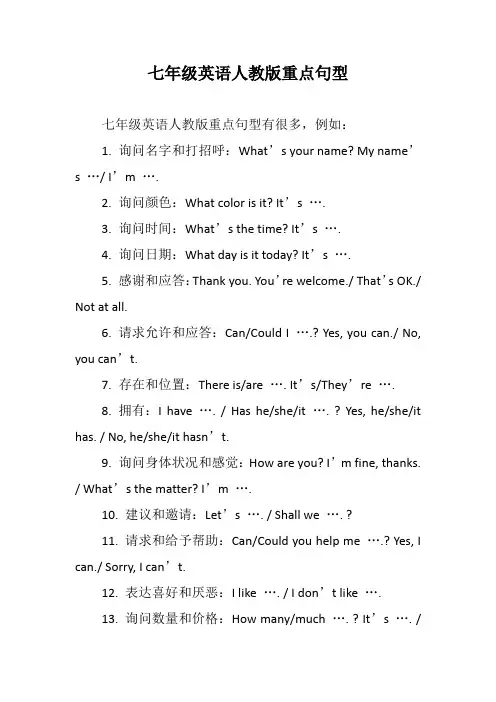
七年级英语人教版重点句型七年级英语人教版重点句型有很多,例如:1. 询问名字和打招呼:What’s your name? My name’s …/ I’m ….2. 询问颜色:What color is it? It’s ….3. 询问时间:What’s the time? It’s ….4. 询问日期:What day is it today? It’s ….5. 感谢和应答:Thank you. You’re welcome./ That’s OK./ Not at all.6. 请求允许和应答:Can/Could I ….? Yes, you can./ No, you can’t.7. 存在和位置:There is/are …. It’s/They’re ….8. 拥有:I have …. / Has he/she/it …. ? Yes, he/she/it has. / No, he/she/it hasn’t.9. 询问身体状况和感觉:How are you? I’m fine, thanks. / What’s the matter? I’m ….10. 建议和邀请:Let’s …. / Shall we …. ?11. 请求和给予帮助:Can/Could you help me ….? Yes, I can./ Sorry, I can’t.12. 表达喜好和厌恶:I like …. / I don’t like ….13. 询问数量和价格:How many/much …. ? It’s …. /They’re ….14. 问路和应答:Excuse me, where’s ….? Go …. / Sorry,I don’t know. / Thank you all the same.15. 表达祝愿和祝贺:Good luck! / Best wishes to you! / Congratulations!16. 打电话:Hello! This is …. / Is that …. ? / Can I speak to ….? / Hold on, please. / Sorry, he/she isn’t in. / Can I take a message for him/her?17. 表达意愿和打算:I want/plan to …. / I hope to …. / I’m going to ….18. 表达请求和建议:Could you please …. ? / Would you like to …. ? / What/How about …. ?19. 表达同意和不同意:I agree./ I don’t agree./ I think …. / I’m afraid ….20. 表达可能和不可能:It’s possible/impossible to …. / I’m sure/not sure ….这些句型在七年级英语学习中非常重要,建议学生们认真学习和掌握。

七年级上册英语全单元重点句型总结一、祈使句及其反义疑问句1. 祈使句的句型为"动词原形+其他",用于表示请求、命令或建议。
例句:Close the door. (关上门。
)2. 祈使句的反义疑问句的结构为"动词原形+其他+will/would/can/could+主语",用于表示疑问、请求或建议。
例句:Open the window, will you? (打开窗户,好吗?)二、一般疑问句及其回答1. 一般疑问句的句型为"助动词/情态动词+主语+动词原形+其他",用于询问事实或情况。
例句:Are you a student? (你是学生吗?)2. 一般疑问句的回答可以用"Yes, 主语+助动词/情态动词"或"No, 主语+助动词/情态动词+not"。
例句:Yes, I am. (是的,我是。
)三、选择疑问句及其回答1. 选择疑问句的句型为"选择疑问词+be/助动词/情态动词+主语+其他",用于提出选择问题。
例句:Where is your school? (你的学校在哪里?)2. 选择疑问句的回答通常是用冒号引导的简短陈述句。
例句:In Qingdao. (在青岛。
)四、特殊疑问句及其回答1. 特殊疑问句的句型为"特殊疑问词+be/助动词/情态动词+主语+其他",用于询问特殊信息。
例句:What's your name? (你叫什么名字?)2. 特殊疑问句的回答是根据问题的具体情况而定,通常是对问题的具体信息做出回答。
例句:My name is Tom. (我的名字叫汤姆。
)五、陈述句及其否定句1. 陈述句的句型为"主语+be/助动词/情态动词+其他",用于陈述事实、描述情况。
例句:She is from France. (她来自法国。
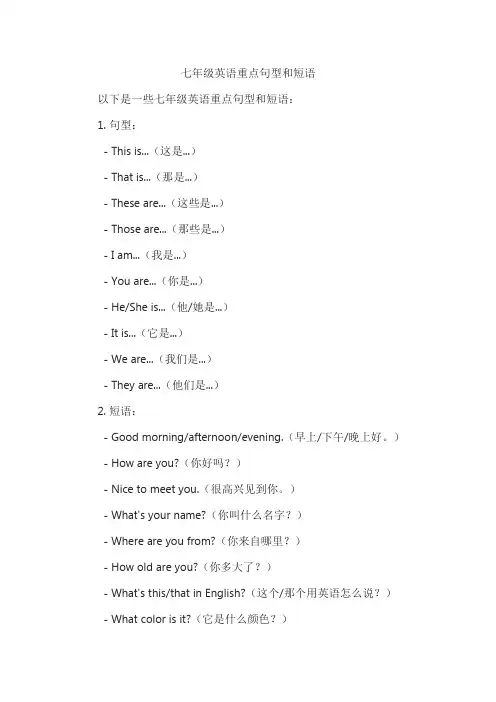
七年级英语重点句型和短语
以下是一些七年级英语重点句型和短语:
1. 句型:
- This is...(这是...)
- That is...(那是...)
- These are...(这些是...)
- Those are...(那些是...)
- I am...(我是...)
- You are...(你是...)
- He/She is...(他/她是...)
- It is...(它是...)
- We are...(我们是...)
- They are...(他们是...)
2. 短语:
- Good morning/afternoon/evening.(早上/下午/晚上好。
) - How are you?(你好吗?)
- Nice to meet you.(很高兴见到你。
)
- What's your name?(你叫什么名字?)
- Where are you from?(你来自哪里?)
- How old are you?(你多大了?)
- What's this/that in English?(这个/那个用英语怎么说?) - What color is it?(它是什么颜色?)
- What day is it today?(今天是星期几?)
- What's the weather like today?(今天天气怎么样?)
- Can you spell it, please?(请问你能拼写它吗?)
这些句型和短语是七年级英语学习的基础,掌握它们可以帮助学生更好地理解和运用英语。
当然,这只是其中的一部分,学生还需要不断学习和积累更多的英语知识。
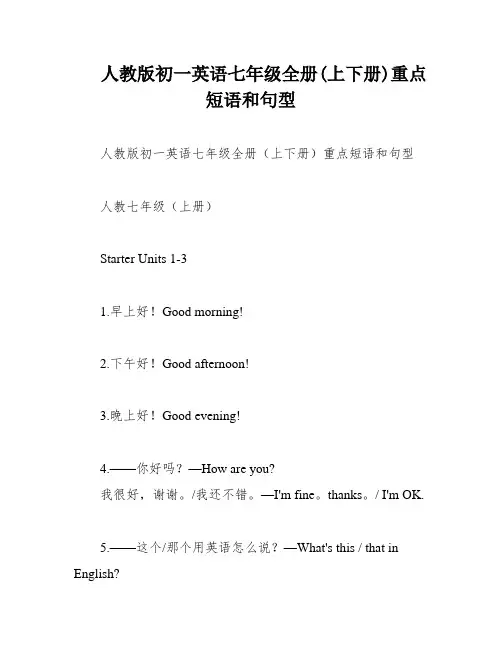
人教版初一英语七年级全册(上下册)重点短语和句型人教版初一英语七年级全册(上下册)重点短语和句型人教七年级(上册)Starter Units 1-31.早上好!Good morning!2.下午好!Good afternoon!3.晚上好!Good evening!4.——你好吗?—How are you?我很好,谢谢。
/我还不错。
—I'm fine。
thanks。
/ I'm OK.5.——这个/那个用英语怎么说?—What's this / that in English?是……—It's a / an。
6.请拼写它。
Spell it。
please.7.——它是什么颜色的?—What color is it? 它是……色的。
—It's。
Unit 1n A1.我是……I'm。
2.你是……吗?Are you。
3.他/她是……He / She is。
4.——见到你很高兴。
—Nice to meet you.见到你我也很高兴。
—Nice to meet you。
too.5.——你/他/她叫什么名字?—What's your / his / her name?我/他/她叫……—My / His / Her name is。
n B1.名字first name2.姓last name3.在中国in China4.学生卡ID card5.这是你的号码吗?Is this your number?6.——你的电话号码是多少?—What's your telephone / phone number?是……—It's。
Unit 2n A1.家庭照片family photos2.这是/那是/这些是/那些是……This is / That is / These are / Those are。
3.她/他是谁?Who's she / he?4.他们是谁?Who are they?5.祝你过得愉快!Have a good day!6.我知道了。

七年级英语重点短语与句型以下是七年级英语中的一些重点短语和句型,包括常用的短语、句子结构和句型模板。
这些短语和句型对于学生在日常交流和写作中起到了重要的作用。
一、常用短语:1.How are you?-你好吗?2.Thank you-谢谢你3.Excuse me-对不起4.What's your name?-你叫什么名字?5.Where are you from?-你来自哪里?6.Can I go to the restroom?-我可以去洗手间吗?7.How much is it?-多少钱?8.I'm sorry-对不起9.What time is it?-几点了?10.I don't understand-我不懂二、句子结构:1.主语+动词:I study English.2.主语+动词+宾语:She reads a book.3.主语+动词+地点状语:He plays soccer in the park.4.主语+动词+时间状语:We have class at 8 o'clock.5.主语+动词+宾语+地点状语:They eat dinner at home.三、句型模板:1.What+be+主语+like?-询问某人的外貌或性格特征。
Example:What is your sister like?-你妹妹长什么样?2.Can+主语+动词原形?-提出请求或询问能力。
Example:Can you help me?-你能帮我吗?3.How+be+主语?-询问某人的状态或感觉。
Example:How are you?-你好吗?4.What+do+主语+like?-询问某人的爱好或喜欢的事物。
Example:What does she like to do?-她喜欢做什么?5.Why+do/does+主语+动词原形?-询问原因或理由。
Example:Why do they go to the park?-他们为什么去公园?通过以上的短语和句型,学生可以在日常交流和写作中灵活运用。
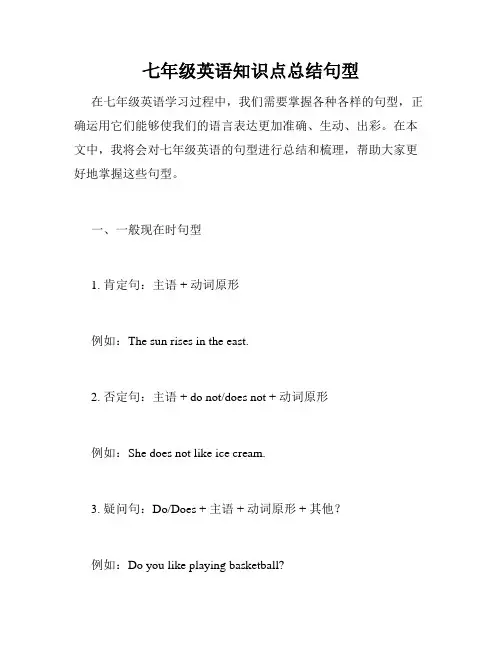
七年级英语知识点总结句型在七年级英语学习过程中,我们需要掌握各种各样的句型,正确运用它们能够使我们的语言表达更加准确、生动、出彩。
在本文中,我将会对七年级英语的句型进行总结和梳理,帮助大家更好地掌握这些句型。
一、一般现在时句型1. 肯定句:主语 + 动词原形例如:The sun rises in the east.2. 否定句:主语 + do not/does not + 动词原形例如:She does not like ice cream.3. 疑问句:Do/Does + 主语 + 动词原形 + 其他?例如:Do you like playing basketball?4. 特殊疑问句:疑问词 + do/does + 主语 + 动词原形 + 其他?例如:What does your mother do?二、一般过去时句型1. 肯定句:主语 + 动词过去式例如:I watched TV last night.2. 否定句:主语 + did not + 动词原形例如:He did not go to school yesterday.3. 疑问句:Did + 主语 + 动词原形 + 其他?例如:Did you have breakfast this morning?4. 特殊疑问句:疑问词 + did + 主语 + 动词原形 + 其他?例如:What did you do last weekend?三、现在进行时句型1. 肯定句:主语 + am/is/are + 现在分词例如:She is reading a book now.2. 否定句:主语 + am/is/are + not + 现在分词例如:They are not playing basketball at the moment.3. 疑问句:Am/Is/Are + 主语 + 现在分词 + 其他?例如:Are you watching TV now?4. 特殊疑问句:疑问词 + am/is/are + 主语 + 现在分词 + 其他?例如:What are you doing this afternoon?四、一般将来时句型1. 肯定句:主语 + will + 动词原形例如:I will visit my grandparents next Sunday.2. 否定句:主语 + will not + 动词原形例如:She will not come to the party tomorrow.3. 疑问句:Will + 主语 + 动词原形 + 其他?例如:Will you go shopping with me this weekend?4. 特殊疑问句:疑问词 + will + 主语 + 动词原形 + 其他?例如:Where will you go for vacation this year?五、情态动词句型1. can 用法:肯定句:主语 + can + 动词原形例如:I can swim very well.否定句:主语+ can not/can’t + 动词原形例如:She can't speak Chinese.疑问句:Can + 主语 + 动词原形 + 其他?例如:Can you help me with my homework?特殊疑问句:疑问词 + can + 主语 + 动词原形 + 其他?例如:What can you do for others?2. should 用法:肯定句:主语 + should + 动词原形例如:You should study hard for the exam.否定句:主语 + should not/shouldn't + 动词原形例如:He shouldn't eat too much junk food.疑问句:Should + 主语 + 动词原形 + 其他?例如:Should we visit the museum tomorrow?特殊疑问句:疑问词 + should + 主语 + 动词原形 + 其他?例如:What should I do to keep healthy?以上是七年级英语中常见的几种句型,希望大家能够认真学习,不断练习,掌握这些句型的用法,提高自己的语言表达能力。
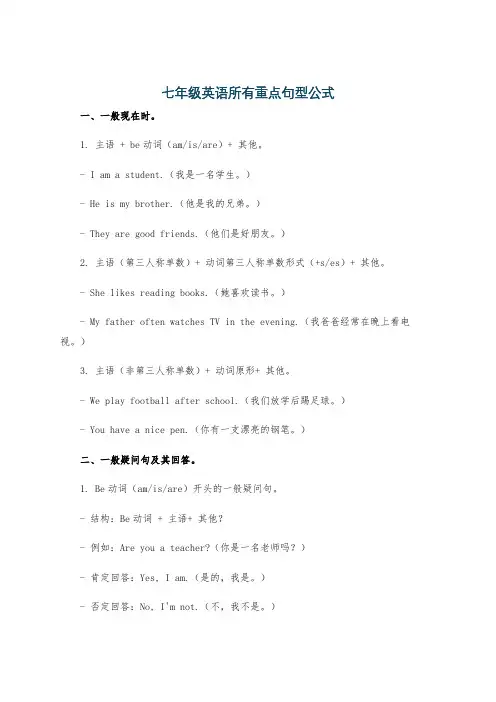
七年级英语所有重点句型公式一、一般现在时。
1. 主语 + be动词(am/is/are)+ 其他。
- I am a student.(我是一名学生。
)- He is my brother.(他是我的兄弟。
)- They are good friends.(他们是好朋友。
)2. 主语(第三人称单数)+ 动词第三人称单数形式(+s/es)+ 其他。
- She likes reading books.(她喜欢读书。
)- My father often watches TV in the evening.(我爸爸经常在晚上看电视。
)3. 主语(非第三人称单数)+ 动词原形+ 其他。
- We play football after school.(我们放学后踢足球。
)- You have a nice pen.(你有一支漂亮的钢笔。
)二、一般疑问句及其回答。
1. Be动词(am/is/are)开头的一般疑问句。
- 结构:Be动词 + 主语+ 其他?- 例如:Are you a teacher?(你是一名老师吗?)- 肯定回答:Yes, I am.(是的,我是。
)- 否定回答:No, I'm not.(不,我不是。
)- Is he at home?(他在家吗?)- 肯定回答:Yes, he is.(是的,他在。
)- 否定回答:No, he isn't.(不,他不在。
)2. 助动词(do/does)开头的一般疑问句(用于行为动词的一般现在时)- 结构:Do/Does+主语+动词原形+其他?- 例如:Do you like music?(你喜欢音乐吗?)- 肯定回答:Yes, I do.(是的,我喜欢。
)- 否定回答:No, I don't.(不,我不喜欢。
)- Does she go to school by bike?(她骑自行车去上学吗?)- 肯定回答:Yes, she does.(是的,她是。
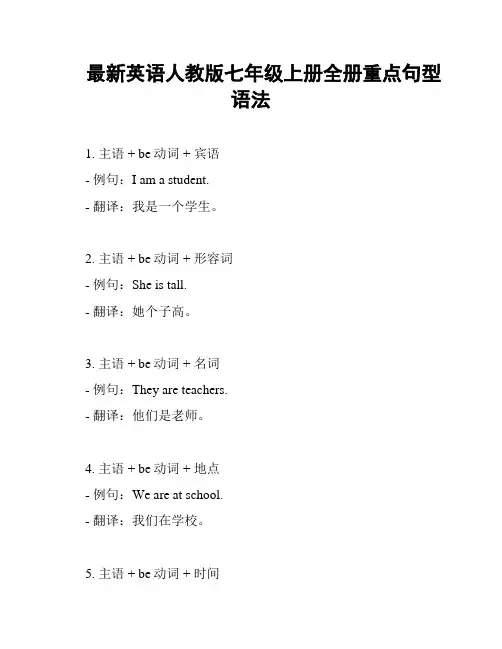
最新英语人教版七年级上册全册重点句型语法1. 主语 + be动词 + 宾语- 例句:I am a student.- 翻译:我是一个学生。
2. 主语 + be动词 + 形容词- 例句:She is tall.- 翻译:她个子高。
3. 主语 + be动词 + 名词- 例句:They are teachers.- 翻译:他们是老师。
4. 主语 + be动词 + 地点- 例句:We are at school.- 翻译:我们在学校。
5. 主语 + be动词 + 时间- 例句:He is in the classroom at 8 o'clock. - 翻译:他在八点钟在教室里。
6. 主语 + be动词 + 副词- 例句:I am here.- 翻译:我在这里。
7. 主语 + have + 名词- 例句:We have a book.- 翻译:我们有一本书。
8. 主语 + have + 动词过去分词- 例句:He has finished his homework.- 翻译:他已经完成了他的作业。
9. 主语 + have + to + 动词原形- 例句:They have to study for the test.- 翻译:他们必须为考试研究。
10. 主语 + can + 动词原形- 例句:She can swim.- 翻译:她会游泳。
11. 主语 + can + 动词原形 + 物品- 例句:We can ride bicycles.- 翻译:我们会骑自行车。
12. 主语 + can't + 动词原形- 例句:He can't speak Chinese.- 翻译:他不会说中文。
13. 主语 + like + 名词/动词/动词-ing- 例句:They like basketball.- 翻译:他们喜欢篮球。
14. 主语 + don't/doesn't + like + 名词/动词/动词-ing - 例句:She doesn't like swimming.- 翻译:她不喜欢游泳。
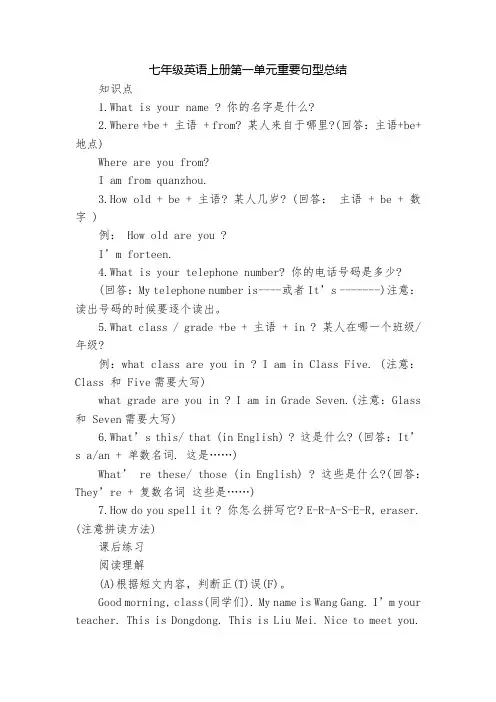
七年级英语上册第一单元重要句型总结知识点1.What is your name ? 你的名字是什么?2.Where +be + 主语 + from? 某人来自于哪里?(回答:主语+be+地点)Where are you from?I am from quanzhou.3.How old + be + 主语? 某人几岁? (回答:主语 + be + 数字 )例: How old are you ?I’m forteen.4.What is your telephone number? 你的电话号码是多少?(回答:My telephone number is----或者It’s -------)注意:读出号码的时候要逐个读出。
5.What class / grade +be + 主语 + in ? 某人在哪一个班级/年级?例:what class are you in ? I am in Class Five. (注意:Class 和 Five需要大写)what grade are you in ? I am in Grade Seven.(注意:Glass 和 Seven需要大写)6.What’s this/ that (in English) ? 这是什么? (回答:It’s a/an + 单数名词. 这是……)What’ re these/ those (in English) ? 这些是什么?(回答:They’re + 复数名词这些是……)7.How do you spell it ? 你怎么拼写它? E-R-A-S-E-R, eraser. (注意拼读方法)课后练习阅读理解(A)根据短文内容,判断正(T)误(F)。
Good morning, class(同学们). My name is Wang Gang. I’m your teacher. This is Dongdong. This is Liu Mei. Nice to meet you.( )1. Dongdong is a teacher.( )2. Liu Mei is a teacher, too.( )3. Wang Gang is a teacher.( )4. They are in the classroom.( )5. Dongdong and Liu Mei are classmates(同学).(B)根据图片的内容,完成下列任务。

七年级上册英语中考重点句型归纳总结20句1. This is my friend Jane. 这是我的朋友简。
2. These are my brothers. 这些是我的兄弟们。
3. Those are my brothers. 那些是我的兄弟们。
4. That’s my family. 那是我的全家。
5. —Are those/these your parents? 那/这些是你的父母吗?—Yes,they are. 是的,他们是。
6. —Who's he? (关注公众号:初一数学语文英语)他是谁?—He’s my brother,Paul. 他是我的兄弟,保罗。
7. 一Who are they? 他们是谁?—They’re my grandparents. 他们是我的祖父母。
8. Here are two nice photos of my family.这是我家两张漂亮的照片。
9. My grandfather and grandmother are in the first photo.我爷爷和奶奶在第一张照片里。
10. In the next picture are my brothers, Bob and Eric.我的兄弟鲍勃和埃里克在下一张照片里。
11.—Where’s the schoolbag? 书包在哪里?—I t ’s under the table. 在餐桌下。
12.—Where are my books?我的书在哪里?—They’re on the sofa. 在沙发上。
13.Where is your ruler?你的尺子在哪里?14.—Where’s my bag? 我的包在哪里?—Is it on your desk? 在你的书桌上吗?15.It’s not under the chair.它不在椅子下面。
(关注公众号:初一数学语文英语)16.I think it ’s in your grandparents’room.我想它在你祖父母的房间里。

英语重点句型一七年级上册1、Good morning/afternoon/evening(to sb)!早上好,下午好,晚上好!2、How are you?你好吗?I'm fine, thanks.我很好,谢谢。
3、Hello! 你好! Hi !你好!4、What's this/that in English ?这个/那个用英语怎么说?It's a jacket./an orange.它是T镀克/—个橘子。
5、Spell it, please.请拼写。
6、What color is it ?它是什么颜色?It's yellow.它是黄色的。
7、What's your name?你的名字是什么?My name's Gina.我的名字是吉娜。
=I'm Gina.我是吉娜。
8、What's his/her name?他/她的名字是什么?His /Her name's Tom/ Gina.他/她的名字是汤姆/吉娜。
=He's /She's Tom/ Gina.他/她叫汤姆/吉娜。
9、Is she Mary?她是玛丽吗?Yes, she is.是的,她是。
/ No, she isn't.不,她不是。
10、Are you Helen?你是海伦吗?Yes, I amo 是的,我是。
/ No, I'm not.不,我不是。
11、A: What's your telephone number?你的电话号码是多少?B: My phone number is 281 -9176.我的电话号码是281 -9176。
12、Nice to meet/see you.见到你很高兴。
Nice to meet/see you, too.见到你也很高兴.13、last name=family name 姓氏first name = given name 名字14、telephone number=phone number 电话号码15、This/That is my friend Jane.这是/那是我的朋友简。
七年级上册英语第二单元重点句型
一、介绍家人的句型。
1. This is my sister.(这是我的姐姐/妹妹。
)
- 用于向他人介绍自己的姐妹。
2. Those are my parents.(那些是我的父母。
)
- 介绍自己的父母,“those”表示复数,指代远处的人或物。
3. Here are two nice photos of my family.(这里有两张我家人的漂亮照片。
)
- “Here be...”句型表示“这里有……”,用来引出要介绍的关于家人的照片等事物。
二、询问人物关系的句型。
1. Who's she?(她是谁?)
- 当看到不认识的女性时,可以用这个句子询问其身份。
- 回答可以是“She is my mother.”(她是我的妈妈。
)等。
2. Who are they?(他们是谁?)
- 用于询问多个不认识的人的身份。
- 回答例如“They are my grandparents.”(他们是我的祖父母。
)
三、描述家庭成员的句型。
1. My father is a teacher.(我的爸爸是一名教师。
)
- 用来描述家庭成员的职业。
2. My mother is very kind.(我的妈妈非常和蔼。
)- 描述家庭成员的性格特点。
初中英语重点句型总结重温重点句型1.So + be/助动词/情牵动词/主语.前面陈述的肯定情况也适于另一人(物)时,常用到这种倒装结构,表示“另一人(物)也如此。
”前面陈述的否定情况也适于另一人(物)时,常用“Neither/ Nor + be/助动词/情态动词+主语.”这种倒装结构。
例如:He likes playing basketball, and so do I.他喜欢打篮球,我也喜欢。
Kate can’t speak Chinese, and I neither/ nor can Jim.凯特不会说汉语。
吉姆也不会。
注意:“So+主语+be/助动词/情态动词.”这一句型常用于表示赞同,进一步肯定对方的看法,表示“的确如此。
”“是呀。
”例如:一Basketball is very popular game in America.篮球在美国是一项很受欢迎的运动。
一So it is.的确如此。
2.Turn right/left at the first/second/…crossing.这一指路的句型意为“在第一/二/……个十字路口向右/左拐。
”相当于Take the first /second/…turning on theright/left.例如:一Can you tell me the way to the nearest post office?你能告诉我去最近的邮局的路吗?一Walk along this road,and turn left at the third crossing.沿着这条路走,在第三个路口向左拐。
3.It takes sb.some time to do sth.此句型表示“干某事花了某人一段时间。
”其中的it是形式主语,后面的动词不定式(短语)才是真正的主语。
例如:It took me half an hour to finish the hard work.完成这项艰巨的工作花了我半个小时。
七年级下册英语重点短语和句型总结1. 重点短语:- be good at (擅长于)- be interested in (对…感兴趣)- get along with (与…相处)- look forward to (期待)- take part in (参加)- be proud of (为…自豪)- be afraid of (害怕)- be similar to (与…相似)- be different from (与…不同)- be famous for (因…而著名)2. 重点句型:-What do you like doing in your free time? (你空闲时间喜欢做什么?)- I'm good at playing basketball. (我擅长打篮球。
)- I'm interested in music. (我对音乐感兴趣。
)- I look forward to seeing you. (我期待见到你。
)- I take part in the school basketball team. (我参加学校篮球队。
) - She is proud of her achievements. (她为自己的成就感到自豪。
)- He is afraid of spiders. (他害怕蜘蛛。
)- My brother is similar to me. (我的兄弟和我相似。
)- My sister is different from me. (我的姐姐和我不同。
)- China is famous for the Great Wall. (中国因长城而著名。
)。
七年级英语句型归纳一、陈述句型1. 主语+谓语+宾语:这是最基本的人称句型,也是英语中最常用的句型。
在这个句型中,主语通常是动作的执行者或承受者,而谓语则描述了动作或状态,宾语则是动作的直接对象。
例如:I have a new book. (我有一本新书。
)2. 主语+谓语:这种句型中只有主谓两个部分,通常用来描述一个事实或情况。
例如:The sun rises in the east. (太阳从东方升起。
)二、疑问句型1. 疑问词+主语+谓语:这种句型用于提出一个疑问或询问某件事情。
疑问词通常是指那些可以用来提问的词语,如what, who, where, when等。
例如:Where did you go yesterday? (你昨天去了哪里?)2. 特殊疑问句:这种句型是在疑问词的基础上加上助动词do的形式构成的。
它通常用来询问某事物的具体情况或状态。
例如:How much money do you earn per month? (你每月赚多少钱?)三、祈使句型1. 动词原形+宾语+其他成分:这种句型用于发出一个命令或请求。
它通常以动词原形开头,后面接上宾语和其他成分。
例如:Please pass me the book. (请把书递给我。
)2. Let祈使句:这种句型通常使用let这个动词来构成祈使句。
它通常用于建议或邀请某人做某事。
例如:Let's go for a walk. (我们一起去散步吧。
)四、感叹句型这种句型用于表达强烈的情感或感叹。
它通常由what或how引导,后面跟主语和谓语。
例如:What a beautiful day it is! (多么美好的一天啊!) / How fast he runs! (他跑得多快啊!)五、there be句型这个句型用于描述存在的情况或描述周围环境。
它通常用来表示某地有某物或某人。
例如:There is a book on the table. (桌子上有本书。
七年级英语句型一、一般现在时句型。
1. 肯定句。
- 主语 + be (am/is/are)+ 表语。
- I am a student.(我是一名学生。
)- He is my brother.(他是我的兄弟。
)- They are my friends.(他们是我的朋友。
)- 主语(第三人称单数除外)+ 动词原形+ 其他。
- I like apples.(我喜欢苹果。
)- They play football on Sundays.(他们在星期天踢足球。
)- 主语(第三人称单数)+ 动词第三人称单数形式 (v - s/es)+ 其他。
- He likes reading books.(他喜欢读书。
)- She goes to school by bike.(她骑自行车去上学。
)2. 否定句。
- 主语 + be (am/is/are)+ not+ 表语。
- I am not a teacher.(我不是一名教师。
)- He is not at home.(他不在家。
)- 主语(第三人称单数除外)+ don't + 动词原形+ 其他。
- I don't like bananas.(我不喜欢香蕉。
)- They don't play basketball.(他们不打篮球。
)- 主语(第三人称单数)+ doesn't+ 动词原形+ 其他。
- He doesn't watch TV in the morning.(他早上不看电视。
)3. 一般疑问句。
- Be (am/is/are)+ 主语+ 表语?- Are you a doctor?(你是一名医生吗?)- Is he your father?(他是你的父亲吗?)- (第三人称单数除外)Do + 主语+ 动词原形+ 其他?- Do you like music?(你喜欢音乐吗?)- Do they go to school on foot?(他们步行去上学吗?)- (第三人称单数)Does+ 主语+ 动词原形+ 其他?- Does she like dancing?(她喜欢跳舞吗?)二、一般过去时句型。
七年级英语重点句型总结
一、介词to系列--这里to是表示方向、去向的介词,后接名词或代词作宾语。
若宾语是人称代词,则要用其宾格形式。
1. give sth to sb(=give sb sth)
当你想表达"把某物给某人"时,那就用它好了。
give后接的是双宾语,指人的sb 为间接宾语,指物的sth为直接宾语。
如:
Give her an apple, please.= Give an apple to her, please. 请给她一个苹果。
2. take sth / sb to ...
此句型意为"把......带到......去",它强调的是带走或拿走(即远离说话人)。
如:Take the book to the teacher's room, please. 请把这本书带到老师的办公室去。
二、动词不定式to系列--这里的to虽然和上面的to一模一样,但它的身份不同:它是动词不定式的"标志词",其后要接动词原形。
看看它在句中的表现吧:
3. help sb (to) do sth (=help sb with sth)
帮助别人也会给自己带来快乐。
帮助某人做某事通常锁定help sb (to) do sth。
它后面的不定式符号to既可以保留,也可以省略,也可接介词with。
如:
Bob helps me(to) learn English at school.(=Bob helps me with my English at school.) 在学校,鲍勃帮我学习英语。
4. like to do sth
每个人都有自己的爱好。
当你喜欢或想去做某件事时,一定要想到like to do sth。
如:
We all like to watch football matches. 我们都喜欢看足球比赛。
5. ask sb to do sth
此句意为"请某人去做某事"。
句中的to do sth是指宾语sb所发出的动作,而不是指主语的动作。
如:
They ask us to have lunch. 他们请我们去吃午饭。
6. It's time to do sth (=It's time for sth)
俗话说Time is money, time is life. (时间就是金钱,时间就是生命。
)所以我们得树立正确的时间观念,该学习时(It's time to study.)就认真学,该玩时(It's time to play.)就痛快玩。
Do you think so?
三、特殊疑问句系列
7. What colour + ...?
这是一个询问颜色的常用句型。
应注意的是,并非对所有带颜色部分提问都用这个句型。
应先分清其在句中所作的成分(详见第15期第2面)。
如:
The car is black. → What colour is the car?
The black car is my father's. → Which car is your father's?
8. What's the time, please? / What time is it, please? 这两个句型都是“请问几点了?”的意思。
当你向对方询问时间时,可用这两个句型。
如:
—What's the time, please? (What time is it, please? ) 请问几点了?
—It's half past eight. 八点半了。
9. How many +复数名词+are there +介词短语?
此句的意思是“在某地有多少……?”。
它后面只能接名词的复数形式,不可接单数名词或不可数名词。
如:
How many children are there in the room? 房间里有多少个孩子?
四、其他
10. There be + ……和动词have表示所有关系不同,There be表示的是一种客观存在。
be动词的形式取决于其后的名词:若接单数名词或不可数名词,用is;若接复数名词,则用are。
当其后接一系列的名词时,be动词一般与最靠近它的名词在数上保持一致。
如:
There is a ruler, two pencils and three pens in the box. 盒子里有一把尺子,两枝铅笔和三枝钢笔。
11. I think ....
在你想发表自己的见解或想法的时候,这句话是最有用的。
表示肯定或否定时,你可以说I think so.或I don't think so.。
12. one ... the other ...该句型的意思是“一个…… 另一个……”,必须用于两者中。
如:
I have two pens. One is red, the other is black. 我有两枝钢笔,一枝是红色的,另一枝是黑色的。
13. Is your friend a boy or a girl?意思是“你的朋友是男孩还是女孩?”,这是一个选择疑问句。
英语中的选择疑问句是由“一般疑问句+ or + 一般疑问句”构成,or后面的一般疑问句与前面相同的部分常省略。
回答时不能用Yes或No 来回答,只能选择其一作答。
上句可这样回答:He is a boy.或She is a girl. 也可直接回答A boy. 或 A girl.。